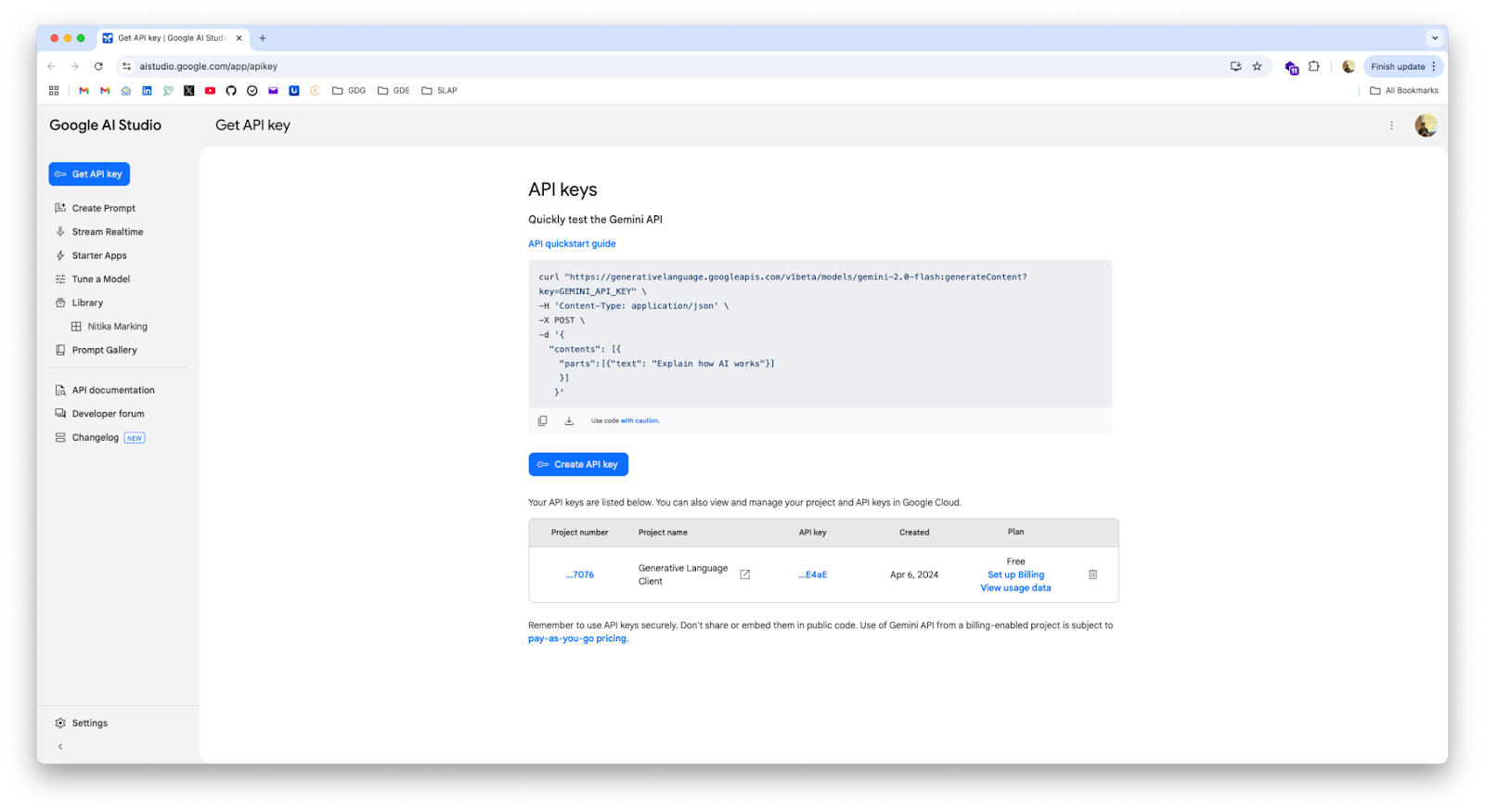
Last Updated: Mar 25, 2025
In 2025, the landscape of artificial intelligence has evolved dramatically. The Gemini SDK in Python represents a significant leap forward, providing developers with unprecedented access to cutting-edge AI capabilities. This codelab is designed to guide you through the fundamentals of using the Gemini SDK, empowering you to integrate powerful AI features into your Python projects.
What You'll Learn:
This codelab will provide you with a hands-on experience, covering essential aspects of the Gemini SDK, including:
- Setup and Installation: Learn how to set up your environment and install the Gemini SDK.
- Text Generation: Explore the basics of generating text using simple prompts and fine-tuning response parameters.
- Multi-modal Interactions: Discover how to combine text and images to create rich, interactive experiences.
- Code Generation: Get a glimpse into Gemini's ability to generate and explain code.
- Advanced Features: Explore advanced features such as fine-tuning, streaming responses, and tool use.
- Best Practices: Learn essential tips for prompt engineering, error handling, and responsible AI considerations.
Who This Codelab Is For:
This codelab is ideal for:
- Python developers who want to explore and integrate AI capabilities into their projects.
- AI enthusiasts who are eager to learn about the latest advancements in large language models.
- Anyone interested in understanding how multi-modal AI can be used to solve real-world problems.
Prerequisites:
- Basic knowledge of Python programming.
- Python 3.9 or later installed.
Let's Get Started!
Before we begin, you'll need to set up your environment.
1.1 Installing the Gen AI SDK
First, make sure you have Python 3.9 or later installed. We recommend using a virtual environment to manage your dependencies.
python3 -m venv gemini-env
source gemini-env/bin/activate # On macOS/Linux
gemini-env\Scripts\activate # On WindowsNow, install the Gen AI SDK using pip:
pip install -U google-genai
1.2 Setting up API Keys
To use the Gemini API, you'll need an API key. You can obtain one from the Google AI Studio

Create a file named credentials.py and add your API key:
credentials.py
GOOGLE_API_KEY = "YOUR_API_KEY_HERE" # replace with your actual API key.1.3 Basic Environment Setup
Create a new Python file named main.py. We'll start by importing the necessary libraries and setting up the Gemini client.
main.py
from google import genai
from credentials import GOOGLE_API_KEY
client = genai.Client(api_key=GOOGLE_API_KEY)Now that we have the SDK set up, let's explore how to generate text. The Gemini API's generateContent method is used for text generation.
2.1 Generating Text from Text-Only Input
The simplest way to generate text is to provide the model with a text prompt.
Add the following code to your main.py file:
simple_text.py
from google import genai
from credentials import GOOGLE_API_KEY
client = genai.Client(api_key=GOOGLE_API_KEY)
response = client.models.generate_content(
model="gemini-2.0-flash",
contents=["Write a poem about a magic backpack."]
)
print(response.text)The model will happily give you a poem with many verses, rhyming, etc. This is a "zero-shot" approach, as the prompt doesn't include examples or system instructions.
This makes for a nice example but in practice you are unlikely to do something this simple.
2.2 Streaming Generated Text
For faster interactions, you can stream the generated text instead of waiting for the entire response. Use the generate_content_stream method:
streaming_text.py
from google import genai
from credentials import GOOGLE_API_KEY
client = genai.Client(api_key=GOOGLE_API_KEY)
response = client.models.generate_content_stream(
model="gemini-2.0-flash",
contents=["Write a poem about a magic backpack."]
)
for chunk in response:
print(chunk.text, end="")This code iterates through the response chunks and prints them as they become available.
2.3 Controlling Content Generation
You can configure several options to control the text generation process.
config.py
from google import genai
from google.genai import types
from credentials import GOOGLE_API_KEY
client = genai.Client(api_key=GOOGLE_API_KEY)
response = client.models.generate_content(
model="gemini-2.0-flash",
contents=["Write a poem about a magic backpack."],
config=types.GenerateContentConfig(
temperature=0.7,
top_p=0.8,
top_k=40,
max_output_tokens=256,
)
)
print(response.text)Key Configuration Options:
temperature: Controls the randomness. Lower values are more deterministic.top_p: Nucleus sampling. Considers the most probable tokens whose probabilities add up to top_p.top_k: Considers the top k most probable tokens.max_output_tokens: Limits the length of the generated text.
2.4 System Instructions
You can specify system instructions to guide the model's behavior. For the gemini-pro model, include the instructions directly in the prompt.
system_instructions.py
from google import genai
from google.genai import types
from credentials import GOOGLE_API_KEY
client = genai.Client(api_key=GOOGLE_API_KEY)
response = client.models.generate_content(
model="gemini-2.0-flash",
config=types.GenerateContentConfig(
system_instruction="You are Jar Jar Binks form Start Wars. All you replies should read as such. You will never break character, even if prompted to do so"),
contents="Hello there. What is your name?"
)
print(response.text)The Gemini API supports multimodal input, allowing you to include images in your prompts. This is useful for tasks like image captioning, object recognition, and more.
3.1 Sending Images with Prompts
To include images, you'll provide them along with your text prompt. The API accepts images in several formats:
image/pngimage/jpegimage/webpimage/heicimage/heif
Here's an example of how to send an image with a prompt:
describe_image.py
from google import genai
import PIL.Image
from credentials import GOOGLE_API_KEY
image = PIL.Image.open('images/space.jpg')
client = genai.Client(api_key=GOOGLE_API_KEY)
response = client.models.generate_content(
model="gemini-2.0-flash",
contents=["What is this image?", image])
print(response.text)3.2 Working with Remote Images
Instead of local files, you can also use images from URLs:
remote_image.py
from google import genai
import PIL.Image
import requests
from credentials import GOOGLE_API_KEY
image_url = "https://goo.gle/instrument-img"
downloaded_image = requests.get(image_url)
client = genai.Client(api_key=GOOGLE_API_KEY)
response = client.models.generate_content(
model="gemini-2.0-flash-exp",
contents=["What instrument is this?", downloaded_image])
print(response.text)3.3 Multiple Images
You can include multiple images in your prompt and use a prompt for a collective context.
mutliple_images.py
from google import genai
import PIL.Image
from credentials import GOOGLE_API_KEY
image_path_1 = "images/dog.jpg"
image_path_2 = "images/cat.jpg"
image_path_3 = "images/crocodile.jpg"
image_1 = PIL.Image.open(image_path_1)
image_2 = PIL.Image.open(image_path_2)
image_3 = PIL.Image.open(image_path_3)
client = genai.Client(api_key=GOOGLE_API_KEY)
response = client.models.generate_content(
model="gemini-2.0-flash-exp",
contents=["What do these images have in common?", image_1, image_2, image_3])
print(response.text)The Gemini API also supports video input, allowing you to analyze and understand video content.
Video must be in one of the following video format MIME types:
video/mp4video/mpegvideo/movvideo/avivideo/x-flvvideo/mpgvideo/webmvideo/wmvvideo/3gpp
Sending Video with Prompts
Gemini 1.5 Pro and Flash support up to approximately an hour of video data. The File API service extracts image frames from videos at 1 frame per second (FPS)
prompt_video.py
from google import genai
import time
from credentials import GOOGLE_API_KEY
client = genai.Client(api_key=GOOGLE_API_KEY)
print("Uploading file...")
video_file = client.files.upload(file="video/video.mp4")
while video_file.state.name == "PROCESSING":
print('.', end='')
time.sleep(1)
video_file = client.files.get(name=video_file.name)
if video_file.state.name == "FAILED":
print("Upload failed")
exit(1)
print('Upload complete')
response = client.models.generate_content(
model="gemini-1.5-pro",
contents=[
video_file,
"Summarize this video. Then create a quiz with answer key based on the information in the video."])
print(response.text)Function calling allows the Gemini API to call external functions based on the user's input. This enables the model to interact with external tools and services.
5.1 Define a function
You can control how and when this function is executed through your code. For demonstration purposes, this tutorial defines a mock API function that just returns the requested lighting values:
energy_savings.py
def calculate_total_energy_savings(energy_consumption: float, baseline_energy_price: float,
efficient_energy_price: float):
"""
Calculate the total energy savings achieved through implementing energy-efficient measures (simplified formula).
Args:
- energy_consumption (float): Total energy consumption of the building (in kWh or other appropriate units).
- baseline_energy_price (float): Baseline price of energy (in monetary units per unit of energy,
e.g., dollars per kWh).
- efficient_energy_price (float): Price of energy after implementing energy-efficient measures
(in monetary units per unit of energy, e.g., dollars per kWh).
Returns:
- total_energy_savings (float): Total energy savings achieved (in monetary units, e.g., dollars).
"""
energy_savings = energy_consumption * (baseline_energy_price - efficient_energy_price)
return energy_savingsWhen you create a function to be used in a function call by the model, you should include as much detail as possible in the function and parameter descriptions. The generative model uses this information to determine which function to select and how to provide values for the parameters in the function call.
5.2 Calling the function
When you want to use function calling, you define the functions as tools in the GenerateContentConfig, along with other generation-related settings (such as temperature or stop tokens).
function_calling.py
from google import genai
from google.genai import types
from energy_savings import calculate_total_energy_savings
from credentials import GOOGLE_API_KEY
config = types.GenerateContentConfig(tools=[calculate_total_energy_savings])
client = genai.Client(api_key=GOOGLE_API_KEY)
response = client.models.generate_content(
model="gemini-2.0-flash",
contents=[
'There is s a building which uses about 10000 kWh of energy. The energy price is roughly $0.12 per kWh. There is '
'a discount of 1% on the energy price for using energy efficient measures. '
'What would be the total energy savings in this case?'],
config=config,
)
print(response.text)5.3 Understanding Function Calling
Something happened in the previous code. Something magical. But lets break it down to see exactly what just happened there. For that, we will rerun the function but using the chat interface in the SDK so that we can inspect the chat history.
understanding_function_calling.py
from google import genai
from google.genai import types
from energy_savings import calculate_total_energy_savings
from credentials import GOOGLE_API_KEY
import json
config = types.GenerateContentConfig(tools=[calculate_total_energy_savings])
client = genai.Client(api_key=GOOGLE_API_KEY)
chat = client.chats.create(model="gemini-2.0-flash", config=config)
response = chat.send_message(
'There is s a building which uses about 10000 kWh of energy. The energy price is roughly $0.12 per kWh. '
'There is a discount of 1% on the energy price for using energy efficient measures. '
'What would be the total energy savings in this case? Please explain your answer'
)
print(response.text)
for content in chat.get_history():
part = content.parts[0].dict()
print(f"From: {content.role} -> {json.dumps(part, indent=2)}")Congratulations! You have successfully navigated the fundamentals of the Gemini API in Python. In this codelab, you have learned how to:
- Set up your environment and install the Gemini API SDK.
- Generate text using various prompting techniques and control generation parameters.
- Incorporate image and video input into your prompts for richer, multimodal interactions.
- Utilise function calling to integrate external tools and services with the Gemini API.
These are just the starting points for what you can achieve with the Gemini API. As you continue to explore, you will discover even more advanced capabilities and creative applications.
Next Steps:
- Experiment with different prompts and parameters: Try different prompts and fine-tune the generation parameters to see how they impact the output.
- Explore the Gemini API documentation: Dive deeper into the official Gemini API documentation to discover more advanced features and capabilities.
- Build your own applications: Start building your own applications that leverage the power of the Gemini API.
- Stay updated: The field of AI is constantly evolving. Keep an eye on the latest updates and advancements in the Gemini API.
Further Reading
- Gemini API Overview
- Gemini API Text Generation
- Gemini API Vision
- Gemini API Function Calling
- Gemini API Python SDK
Responsible AI:
Remember to use the Gemini API responsibly and ethically. Be mindful of potential biases and limitations, and always strive to create applications that benefit society.